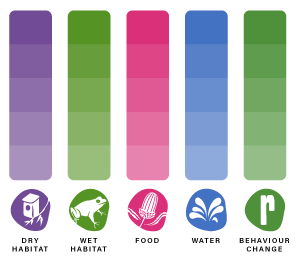Dry Shelter
Dry shelter includes features that offer protection from the elements, refuge from predators and/or somewhere to nest. This includes tree canopies for birds, groundcover and grasses for lizards and critters, or even novel habitats (manmade constructions, like nest boxes).
Wet Shelter
Wet shelter includes damplands, ponds and wildlife baths. These habitats may also supply drinking water (see below), but is measured here for providing homes, refuge and nesting opportunities for animals such as frogs, dragonflies, lizards and small songbirds.
Food
When we talk about wildlife, we mean the entire ecological system – plants and animals – all of which form a part of the food web. We are not talking about actively feeding wildlife.
For example, a plant that provides food for pollinating insects and other critters is essential if you want to attract birds and other animals that eat insects. Going the other way, some plants depend on insects to keep soil healthy and aerated so that they can draw up nutrients.
Our native species have evolved together to create a food web that is under serious pressure from human activities. ReWild Perth primarily values food habitat in terms of a plant’s ability to feed animals directly.
Water
Water is essential to life on this planet. Native wildlife that has evolved for our conditions doesn’t necessarily need a lot of water. The provision of water in terms of ReWild habitat value typically refers to access to drinking water for animals, although clever design can allow this habitat value to be combined with Wet Shelter.
Behaviour change goals allow us to protect the environment without necessarily adding habitat to our site. Because they require a longer-term commitment, we have determined that any one of the following actions will automatically earn one full ReWild star to your rating. However, you can only achieve the behaviour change star once – you can’t add them together – although this shouldn’t stop you from doing more if you can.
The behaviour change actions are as follows:
Help my local environment group.
Keep my cat indoors from now on.
Keep my outdoor cat away from wildlife.
Keep my dog away from wildlife.
The ReWild scoring system isn’t a competition – it’s a way to measure your progress and think about what habitat features you can include in your garden design to encourage wildlife.
Many people will start with a score of One or Two, even if they have an established garden, simply because they haven’t thought about how to incorporate plants that provide food for birds – a simple birdbath or pond introduces important features that turn a garden into habitat.
A ReWild Level of Three is a great achievement, representing a garden that has been adapted to create significant habitat value, combining aspects of several Habitat Values and (usually) a behaviour change score.
We will be monitoring the whole process and make adjustments to the scoring system based on your feedback.
In this version, we have supplied goals in your action list that indicate the minimum number of times an action needs to be completed to get the maximum* value for that action.
* NB: It is not necessary to achieve the maximum value for every action. Most actions contribute to one or two habitat values, and it is the combined habitat values and combinations that generate your ReWild Level. You can complete the goals for all or the actions regarding trees, shrubs, small plants and wildflowers and still receive a ReWild Level of Two, because all of those actions contribute to the same two Habitat Values (Dry Shelter and Food). Get a higher score by including Wet Shelter, Water and/or Behaviour Change actions.
We have tried to make ReWild as simple as possible for you, but significant research has been undertaken to ensure the broader goal of repopulating Perth’s unique ecological system to bring nature home.
We start with the soil
The geographical ReWild Perth area historically has five distinct soil types. Some of the plants that have evolved here prefer certain soil types; some have adapted to grow anywhere. We have mapped each suburb to its dominant soil type, so the plant lists supplied for each suburb provide a curated list indicating the types of plants that would naturally occur in that area.
All about flora
Plants well-adapted to your location means they will perform well and establish quickly. Healthy plants are much better equipped to withstand disease, extreme weather conditions, and subtle variations in the environment. More importantly, healthy plants grown in ideal conditions quickly become the foundation for a thriving ecosystem within the garden. These will attract and support a wide range of wildlife from native butterflies, birds, reptiles, mammals, and other critical critters.
Critical ‘Critters’
You might be surprised at the number of resources that focus on insects and creepy-crawlies. However, these ‘critical critters’ are fundamental for a healthy food web, providing ecological services to the soil, food for other animals, and some acting as pollinators. As a general rule, we do not advise widespread use of pesticides, as it destabilises the entire ecosystem.
Urban wildlife
The overarching goal for ReWild is to provide habitat that allows our native — and sometimes threatened — wildlife species to survive in urban areas. We have provided significant resources on our local animals, particularly marsupials and birds. Each animal profile links to the resources that will provide habitat values for that species. These may include food or shelter-providing flora, water sources, nesting boxes and refuge homes. We hope that by exploring these resources, you will gain a greater understanding of what makes our region ecologically significant, while providing you the information you need to help make a difference.

